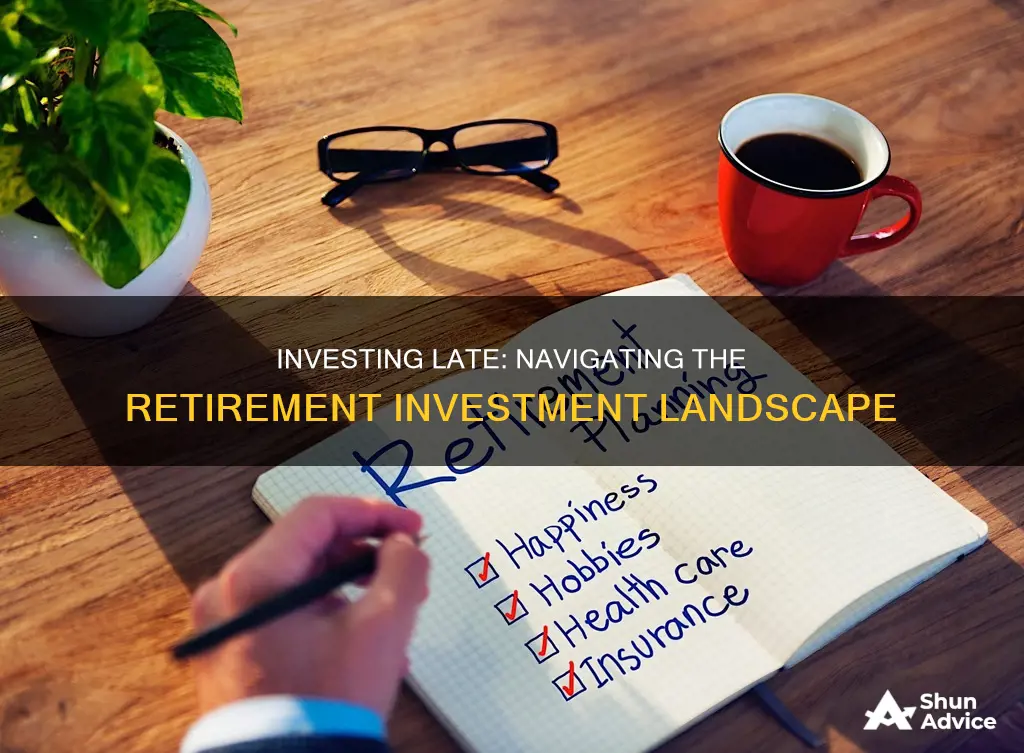
Investing for retirement is a long-term strategy that requires careful planning and diversification. As you approach retirement, it's crucial to assess your financial situation and make adjustments to secure a stable income during your non-working years. Here's an introduction to some key considerations for investing close to retirement.
As you near retirement, it's essential to reduce risk in your investment portfolio. This means shifting from high-risk investments to more stable, low-risk options. Diversifying your investments across asset classes such as stocks, bonds, cash, and real estate is crucial to minimising risk. Additionally, it's important to have accessible funds in high-yield savings accounts to cover short-term expenses.
Retirement planning also involves understanding your risk tolerance, which may change as you get closer to retirement. Seeking advice from financial professionals can help you navigate market volatility and make informed decisions about your investments.
Another important aspect is maximising your savings by taking advantage of tax-advantaged retirement accounts, such as 401(k)s and Individual Retirement Accounts (IRAs), which offer tax-deferred or tax-free growth.
Lastly, it's crucial to have a clear understanding of your retirement goals and adjust your investment strategies accordingly. This includes considering your expected expenses, lifestyle changes, and any other factors that may impact your financial needs during retirement.
| Characteristics | Values |
|---|---|
| Savings accounts | High-yield savings accounts |
| Investments | Low-risk, short-term bonds, TIPS, annuities, dividend-paying stocks, rental properties, REITs, mutual funds, fixed deposits, PPF, NPS, RBI bonds, NSC, SCSS |
| Asset allocation | More conservative, less risky investments |
| Risk | Less risk as you get closer to retirement |
| Financial advice | Seek advice from a financial professional |
What You'll Learn

Focus on your retirement goals, not the news headlines
When you're approaching retirement, it's crucial to focus on your goals and not get distracted by the noise of news headlines. Here are some detailed instructions and considerations to keep in mind:
Set Clear Retirement Goals:
Start by defining your retirement goals and priorities. Do you want to downsize your home or purchase a second property? Are you planning to travel extensively or take up new hobbies? Do you want to leave a legacy for your family or donate to charitable causes? Setting clear goals will help you stay motivated and guide your financial decisions.
Create a Retirement Budget:
Understanding your monthly expenses in retirement will help you determine how much you need to save and the lifestyle you can afford. Consult a financial advisor to get an accurate estimate of the costs associated with your retirement plans and to ensure you have enough set aside.
Reduce Investment Risk:
As you get closer to retirement, it's generally advisable to reduce the risk in your investment portfolio. Shift your focus from high-risk investments to more stable, low-risk options. This could include increasing your allocation of bonds, exploring Treasury Inflation-Protected Securities (TIPS), or considering other low-risk investments like high-yield savings accounts or short-term bonds.
Stay Informed but Don't React to Headlines:
Market volatility and economic news can be distracting, but don't make impulsive financial decisions based on short-term headlines. Remember that your investment strategy should be based on your long-term goals, risk tolerance, and time horizon. Work with a financial advisor to ensure your investments align with your retirement plan and make adjustments as needed.
Focus on Your Risk Profile:
Everyone has a unique risk profile based on their financial situation, goals, and comfort level. Some individuals are comfortable with a more aggressive approach, while others prefer stability. Understand your risk tolerance and ensure your investments match your profile. This may involve moving your investments from emerging markets to developed economies or shifting from small-cap to large-cap stocks.
Plan for the Long Term:
Retirement can last for decades, so it's essential to plan for the long term. This includes considering how you want to live in retirement. Will your expenses go down, stay the same, or increase? Planning for different scenarios will help you adjust your savings and investment strategies accordingly.
Remember, the key is to stay focused on your retirement goals and work with a financial professional to make informed decisions. This will help ensure that short-term news and market fluctuations don't derail your long-term plans.
Delta Airlines: Invest Now?
You may want to see also

Control what you can, like salary deferral contributions
Salary deferral plans, such as 401(k)s, 403(b)s, and 457(b)s, are a great way to save for retirement. These plans allow you to invest a portion of your salary before taxes are applied, giving your money the opportunity to grow over time. Here are some key advantages of salary deferral contributions when investing close to retirement:
Tax Benefits
Salary deferral plans offer significant tax advantages. Contributions are typically made on a pre-tax basis, which means taxes are postponed until you withdraw the funds during retirement. This lowers your taxable income in the year you contribute, resulting in a lower tax bill. Additionally, your retirement plan earnings aren't taxed annually, allowing more of your money to grow through compounding.
Employer Matching
Many companies offer employer-matching funds as an incentive for employees to contribute to their salary deferral accounts. This means your employer will match a certain percentage of your contribution, essentially giving you free money to save for retirement. It's like receiving a bonus just for saving!
Investment Control
While salary deferral plans may have pre-selected investment options by your employer, you have control over how your money is invested. You can choose from a range of options, including conservative stable value funds, certificates of deposit (CDs), bond funds, and growth stock funds. This allows you to create a diversified portfolio that aligns with your risk tolerance and financial goals.
Compounding Potential
By contributing to a salary deferral plan, you increase the potential for compounding returns. Compounding is a fundamental principle of investing, where earnings generate their own earnings over time. With tax-deferred accounts, you invest your funds before paying taxes on them, maximizing the compounding effect.
Discipline for Early Withdrawals
Salary deferral plans, such as traditional IRAs and 401(k)s, typically come with penalties for early withdrawals. For example, withdrawing funds before the age of 59½ may result in a 10% early withdrawal penalty. This acts as a deterrent, helping you stay disciplined and avoid tapping into your retirement savings prematurely.
Dubai's Investment Trends
You may want to see also

Match your investment risk with your age and risk tolerance
When it comes to investing, risk tolerance is a crucial factor to consider, especially when nearing retirement. Risk tolerance refers to the degree of risk an investor is willing to take, given the potential for losses or gains in their investment portfolio. As people age, their risk tolerance tends to shift, with younger individuals generally having a higher tolerance for risk. However, it's important to remember that age is not the sole determinant of risk tolerance, and other factors such as investment goals, income, and net worth also play a significant role.
As you approach retirement, it's essential to assess your risk tolerance and adjust your investment strategy accordingly. Here are some guidelines to help you match your investment risk with your age and risk tolerance:
- Understand your investment goals: Are you saving for retirement or something else? The closer you get to retirement, the more important it is to ensure your investments are aligned with your goals. If you're saving for retirement, you may want to focus on investments that provide stable income and preserve your principal investment.
- Assess your risk capacity: Risk capacity refers to your financial ability to take risks. As you get closer to retirement, you may have a smaller margin for error. Consider your current income, future earning potential, and the presence of other assets when evaluating your risk capacity.
- Time horizon: The time horizon of your investments also plays a role in determining your risk tolerance. If you're nearing retirement, you may have a shorter time horizon and therefore a lower risk tolerance. However, with increasing life expectancies, even retirees may have a longer time horizon than traditionally assumed.
- Adjust your asset allocation: As you get closer to retirement, it's generally recommended to shift from aggressive investments like stocks to more stable, lower-risk investments like bonds and cash. This helps protect your portfolio from market volatility and reduces the potential for significant losses.
- Seek professional advice: Consult a trusted financial advisor or planner to review your investment portfolio and make adjustments based on your age, risk tolerance, and retirement goals. They can provide personalized advice and help you navigate the complexities of investing near retirement.
- Emergency funds: It's important to have a sufficient emergency fund in place, typically recommended as three to six months' worth of living expenses. This can provide a buffer and reduce the need to dip into your investments prematurely.
Remember, investing near retirement involves carefully balancing risk and return. While reducing risk is prudent, eliminating risk altogether may not be advisable as it could impact your portfolio's growth potential. Work with a financial professional to tailor your investment strategy to your specific circumstances and ensure you're on track for a comfortable retirement.
The Workforce Investment Act: Unlocking Tuition Support for Career Seekers
You may want to see also

Consult a financial professional for personalised advice
Consulting a financial professional for personalised advice is a good idea when you are close to retirement. Financial advisors can provide a wide range of products and services to help you with your financial circumstances at different life stages. They can help you with savings and investments, tax and estate planning, and insurance coverage.
When you go to a professional financial advisor, they will carry out a 'fact-find'. This involves asking you detailed questions about your circumstances, such as your current financial situation and your appetite for risk. They will then set out a plan for you based on that information, including recommending financial products that are suitable for you.
There are different types of financial advisors, including fee-only, fee-based, commission-based, and registered investment advisors. It is important to understand how they earn money and whether they are bound by fiduciary duty, legally requiring them to work in your financial best interest.
When hiring a financial advisor, you should first decide what part of your financial life you need help with. Then, research and interview potential candidates, considering their credentials, experience, and fee structures. Finally, have an initial consultation to ensure they are a good fit for your needs.
A financial advisor can help you set the right course for retirement and identify unexpected areas for improvement. They can provide valuable expertise in managing your retirement income and investments, as well as navigating tax considerations.
It is important to note that financial advisors are not just for the wealthy. Anyone can benefit from financial guidance, especially when approaching retirement, to ensure you are making informed decisions and staying on track with your financial goals.
Investments: Where is the Money Going?
You may want to see also

Diversify your investments with a simple asset allocation model
Diversifying your investments with a simple asset allocation model is a crucial step in planning for retirement. Here's a detailed guide on how to do this effectively:
Understanding Asset Allocation
Asset allocation involves dividing your investment portfolio across different asset categories, such as stocks, bonds, and cash. The mix of assets you choose depends on your personal financial goals, time horizon, and risk tolerance. Your time horizon refers to the expected duration of your investments, whether it's short-term or long-term. Risk tolerance is your ability to tolerate potential losses and volatile market conditions.
Stocks, Bonds, and Cash
Stocks, bonds, and cash are the three primary asset categories. Stocks historically have the highest risk and potential returns. They offer significant growth opportunities but also come with volatile short-term performance. Bonds are generally less volatile and provide more modest returns. Cash and cash equivalents, such as savings accounts and money market funds, are the safest investments but typically offer the lowest returns.
Asset Allocation Models
Income Portfolio: This model allocates 70% to 100% of your investments to bonds, focusing on capital preservation and stable returns.
Balanced Portfolio: A balanced approach allocates 40% to 60% to stocks, striking a balance between growth and income.
Growth Portfolio: A growth portfolio allocates 70% to 100% to stocks, prioritizing long-term capital growth and higher returns.
Implementing Asset Allocation
You can implement asset allocation using target-date funds, which automatically adjust the mix of investments as you approach retirement. These funds typically include a mix of domestic and international stocks and bonds. As you get closer to retirement, they shift towards more conservative investments like bonds to reduce volatility.
Alternatively, you can use a two-fund or three-fund portfolio with index funds. A two-fund portfolio might consist of a total world stock index fund and a total bond market index fund. A three-fund portfolio adds more control by dividing the stock allocation between U.S. and international equities.
Key Considerations
When diversifying your investments, keep the following in mind:
- Risk Tolerance: Consider your risk tolerance and adjust the mix of assets accordingly. If you have a higher risk tolerance, you may allocate more to stocks; if you're more conservative, you might favor bonds and cash equivalents.
- Time Horizon: Your time horizon will influence your choice of asset allocation. Longer time horizons may allow for more aggressive investments, while shorter time horizons might call for more conservative strategies.
- Investment Fees: Be mindful of investment fees and expenses, as they can impact your overall returns. Aim to keep your investment expenses as low as possible.
- Periodic Review: Regularly review and rebalance your portfolio to ensure it aligns with your financial goals and risk tolerance. As you approach retirement, you may need to adjust the weighting of your assets.
By following these guidelines and choosing an asset allocation model that suits your needs, you can effectively diversify your investments and work towards a comfortable retirement.
Zack's Investment Recommendations: Current Insights
You may want to see also
Frequently asked questions
Low-risk investments include US Treasury bonds, Treasury Inflation-Protected Securities (TIPS), US savings bonds, municipal bonds, annuities, and cash value of life insurance.
Focus on your retirement goals and achievements, not the news headlines. Control what you can by reviewing and adjusting your contributions. Match your investment risk with your age and risk tolerance. Check in with a financial professional for personalised advice.
Asset allocation is a strategy that determines how much money to put into stocks, bonds, and cash. Younger investors can tolerate more risk and thus allocate more to stocks, whereas those closer to retirement should shift towards more stable, low-earning funds like bonds and money markets.
Tax-advantaged retirement accounts include 401(k)s and Individual Retirement Accounts (IRAs). These are available in "traditional" and "Roth" options, offering different tax benefits.
Other investment options include mutual funds, bank fixed deposits, Public Provident Fund (PPF), National Pension System (NPS), and RBI savings bonds. Diversifying across asset classes and investment avenues can help pave the path to a comfortable retirement.







